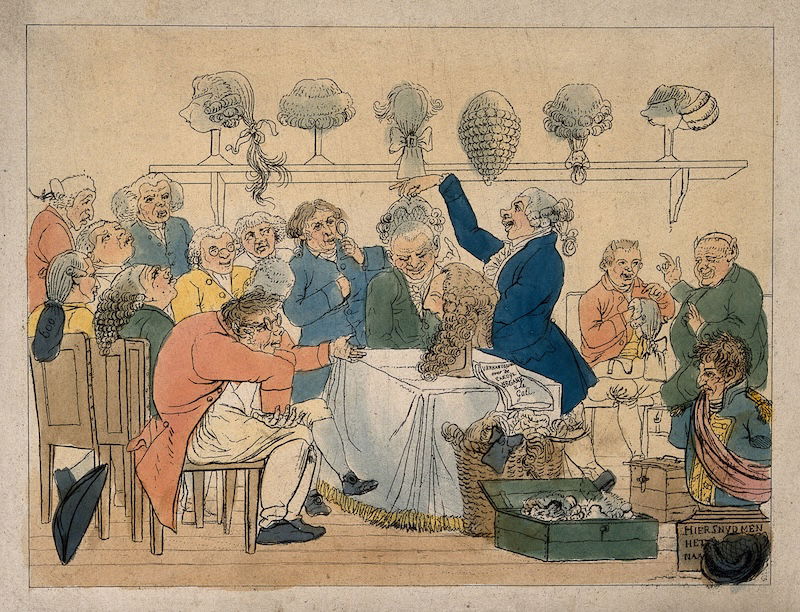A rather unusual petition from October 1716 is tucked away in the pope’s diocesan archives in the basilica of San Giovanni in Rome:
Antonio Piervenanzi, parish priest of San Benedetto in Piscinola, has found himself in poor health since the month of September on account of a continuous flux that descends from his head and affects his whole body. He has constant pain inside and outside and, for this reason, has remained without hair and almost without teeth, with dizziness and temporary blindness. Doctors fear that a greater, even unrecoverable, illness could occur. Piervenanzi, on the advice of those who treat him, therefore asks permission to wear a light wig in natural colours, with a tonsure and without curls.
Why would an 18th-century priest need to ask the pope’s permission to wear a wig?
The underlying context of Piervenanzi’s petition was the contemporaneous fashion craze for carefully coiffured false hair. Think of portraits of Louis XIV, J.S. Bach, Marie Antoinette, the Founding Fathers, or the ‘hanging judge’ George Jeffreys. A wig, the larger and the more elaborate the better, was a must-have for any person of importance. Indeed, the great English church historian Owen Chadwick once remarked how ‘the wig became as necessary to the uniform of Anglican bishops as to that of English judges’. Yet Chadwick also noted that the same was not true of Catholic clerics. For several generations, numerous bishops in France and Italy waged a concerted campaign against priests who wore them.
Pietro Maria Orsini, an archbishop of Benevento who in 1724 became Pope Benedict XIII, was at the forefront of this crackdown. A lifelong Benedictine monk, and also the 18th century’s only fully bald pope, he may have approached the subject of wigs from a particularly personal perspective. Yet, like other ‘wig critics’ in the Catholic hierarchy, he saw artificial hair as vain, inappropriate and eccentric.
In Benedict’s critique, a priest who wore a wig to fit in with fashionable trends in wider society was exhibiting a misguided, even unholy, attachment to the secular. The 16th-century saint and archbishop of Milan Carlo Borromeo had previously said as much. In a famous pastoral letter, he admonished his diocesan clergy for neglecting godliness, which was clean-shaven, in favour of that century’s male grooming fad, the bushy beard.

Wearing a wig was even worse than sporting a beard, wig critics argued, because it broke a key injunction in the Church’s sacred law. Paul’s First Letter to the Corinthians states that ‘every man who prays or prophesies with his head covered dishonors his head’ and also that ‘a man ought not to cover his head, since he is the image and glory of God; but woman is the glory of man’.
Many throughout history have interpreted these verses to mean that men, though not women, must remove their hats in church. And what was a wig if not a kind of hat? How could a priest who was in breach of this rule stand before the altar and utter the Blessed Sacrament’s holy words? The scandal undermined its efficacy.
As pope, Benedict XIII issued three edicts in just three years which mention wigs. Other popes had prohibited wearing wigs in church, but his proscriptions were the harshest yet: a priest who brought his wig anywhere near a sacred space, even a sacristy, could be sentenced to 15 days in prison, an indeterminate monetary fine and suspension of his rights to celebrate.
There is scant evidence that Benedict was able to catch any offending clerics – or, if any were caught, to punish them for their misdemeanours. He simply lacked the resources to monitor or prosecute his ban effectively. The problem for him, as for other Church leaders, was that many Catholic priests dissented from the anti-wig policy. They may have been men of the cloth, but they did not share all of their superiors’ beliefs. They also wanted to participate in a wider social order beyond the Church itself, where wigs signalled that those who wore them were respectable persons of status.
The next pope but one, the celebrated ‘Enlightenment Pope’ Benedict XIV (r.1740-58), recognised the problem and so took a different approach. Intent mattered, he suggested. A priest who wore a modest, unostentatious wig out of medical necessity did nothing wrong. It was only excessive concern for outward appearance that was a sin.
This, of course, was the position advanced by the priest Piervenanzi in his petition of 1716. But Piervenanzi was unlucky: his argument was ahead of its time (and his request denied). A few other priests who pleaded similar cases did better because they argued more forcefully that they needed the wig to reduce levels of disgust (and therefore scandal) among their congregations. The Church viewed priests whose bodies were imperfect with great suspicion. The argument about disgust had to be taken seriously because it threatened the priest’s parishioners’ souls if his ugliness caused them to avoid church.
The Vatican’s Congregation of the Council, a body established to regulate conduct among religious, was often called in to adjudicate such cases. It ruled that hermaphrodites could be priests but not nuns, for example. It also decided the case of Antonio Maniardo, a monastic doorkeeper sacked when his bad stammer prevented him from discharging his duties. Maniardo argued that his duties were performed through bodily actions rather than through speech, which meant that his disability was no object to it. He seems to have been less successful than other priests, who got to keep their wigs.
The Church’s problem with wigs eventually solved itself. They went out of style after the French Revolution and soon every Catholic cleric was embarrassed that any predecessors had ever worn one. Pius VI (r.1775-99), the only wigged pope, was later said only to have worn powder in his hair. Priests who wear wigs today are too discreet to tell us.
Miles Pattenden teaches History at the University of Oxford.
